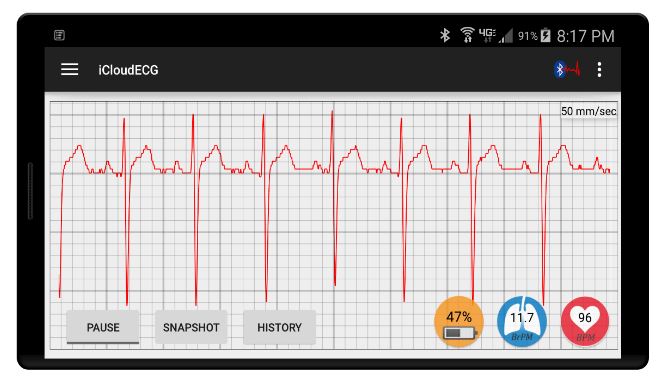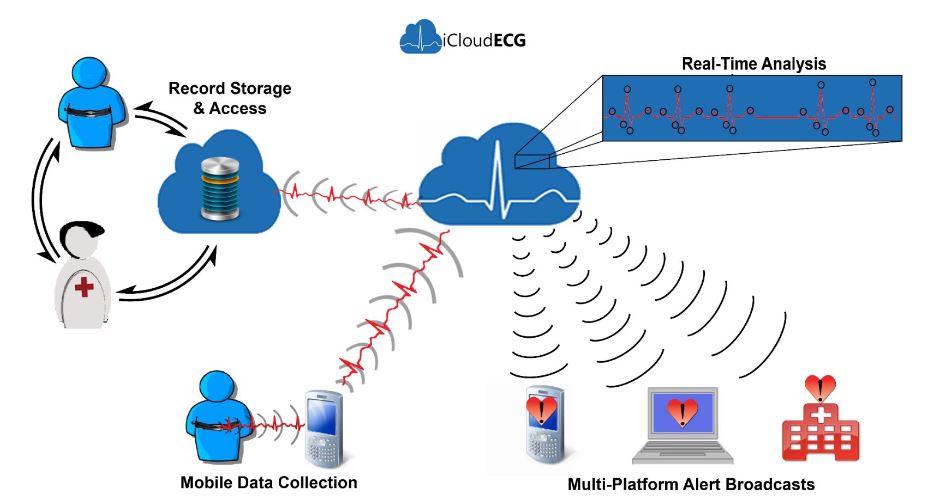ABSTRACT
With rising healthcare costs and a substantially growing number of patients 65 or over, the benefits of telemedicine and patient self-monitoring systems are becoming increasingly evident. Patients, physicians, hospitals, and even insurance providers benefit from vigilant, cost-effective patient monitoring systems. This thesis describes the development of a portable, smart-phone connected system for continuous cardiac monitoring.
The system is capable of continuously monitoring the conditions of the heart, automated detection of cardiac arrhythmias, and real-time notifying patients and physicians of the detected abnormalities. The system consists of four main subsystems: 1) a Bluetooth capable chest-strap ECG, 2) an Android-enabled mobile device, 3) a cloud-based analysis, storage, and notification system, and 4) a web-application portal. Data is collected by the single-lead ECG device, and transmitted to the mobile device via Bluetooth.
An application allows the patient to view their ECG output in real-time, view the last 24 hours of recordings, and receive notifications and details regarding any detected abnormalities. The mobile device transmits the ECG data to a remote server for pre-processing and analysis, and then stores the data in a database which the patient or physician can access via a web-interface. The developed system can be used as a telemedicine system for management of cardiovascular diseases.
LITERATURE REVIEW
Telemedicine—the use of telecommunications for medical diagnosis, treatment, and remote monitoring—is one of the tools being used to help curb the costs of healthcare. Telemedicine allows physicians to provide patient care outside of a clinical setting, giving both patients and physicians drastically increased mobility. This is meant to cut down the need for clinical visits and hospital stays, and allow for earlier detection and diagnosis of various conditions. In many cases, the earlier an illness is detected, the more successful and inexpensive it is to resolve or manage.
MATERIALS AND METHODS
Figure 6–A general overview of the iCloudECG system. ECG data is sent from the collection device to the mobile phone, then it is uploaded to the analysis server. After analysis, the ECG data is sent to storage, where it can be accessed by either the patient or the physician. The analysis server also generates notifications which can be sent to the user’s mobile device or computer, or they can be sent to the patient’s physician or hospital.

Figure 9–Mobile application main screen
If the record analysis determines there is an abnormality, those results are packaged and sent through Google Cloud to the mobile device. A listener service receives the analysis information and generates an alert notification, which the user selects and is taken to a screen with additional information. The user can also view a database, generated by the data handling service, where they are presented with a list of each record’s summary information. The records are color coded to highlight ones with abnormalities—green for normal, and red for abnormal. The user can select a record to either view the plot of its ECG data, or to review details of the record’s analysis results.
USER SCENARIOS
iCloudECG has been designed as a versatile, multi-platform system, with a range of applications. In its most basic form the system can be used by individual users, independently of a physician, to monitor their own cardiac health. The system can also be used by care-providers and relatives to monitor elderly or disabled individuals, or it could be used to monitor athletes during exercises and events. An advanced modification of the system would integrate cardiac physicians, allowing remote monitoring and evaluation of a patient’s cardiac health.
CONCLUSIONS AND FUTURE WORKS
With a growing percentage of the population being age 65 or over and the rising costs of healthcare, advances in the efficiency, efficacy, and affordability of patient care would not only be of great benefit to patients, but also physicians and even insurance providers. Telemedicine and patient self-monitoring systems have the potential to significantly reduce the average cost of healthcare, while at the same time improving the quality of patient’s lives. With cardiovascular disease as the number one cause of death, and its overwhelming presence in the elderly population, cardiology is a primary field in which to implement these technologies.
iCloudECG was designed to give patients and physicians a streamlined cardiac monitoring and diagnostic system-providing continuous ECG monitoring with automated cardiac abnormality recognition and alerts, all without hindering the patient’s mobility or taking time away from their lives. The patient cost of iCloudECG would be substantially lower than most Holter systems currently in use, with the added advantages of long term continuous monitoring with real-time data analysis. The system’s flexibility make it applicable in a variety of user scenarios: from stand-alone users wanting to know more about their cardiac health, to a remote patient monitoring and diagnostics system for use by cardiac physicians.
Further development is needed on various aspects of the system. The physician side of the system will require consultation from multiple physicians to determine what features would be most useful. A physician application needs to be developed that will organize all of their enrolled patients data and analysis results for quick and easy examination. The web-application portal needs to be expanded with a similar interface. Considerations should be made about who will actually be accessing the portal—the physicians themselves, or their nurses—and how this will affect the design of the interface to make it easiest and most efficient for those users.
Source: The University of Tennessee, Knoxville
Author: David S. Clifford
